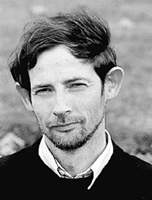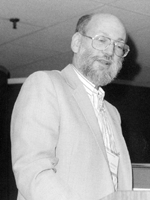UK/Ireland SIAM Section Holds Annual Meeting in London
April 16, 2000

John Ball (above), who opened the annual meeting of SIAM's UKIE section with a talk on open problems in elasticity theory, had been recognized earlier by SIAM for his work in that and related areas. In Atlanta last May, at the 1999 SIAM Annual Meeting, Ball and Stuart Antman (below) received the 1999 Theodore von K�rm�n Prize. The prize is awarded every five years for a notable application to mechanics and/or the engineering sciences. Ball, a researcher in the Mathematics Institute at Oxford University, was cited "for his deep contributions to infinite dimensional dynamical systems, existence theory in nonlinear elasticity, quasiconvexity, cavitation, and microstructures." In the lecture he gave in Atlanta, "Microstructure and the Austenite-Martensite Transition," he described his joint work with Carsten Carstensen that uses nonlinear elasticity to describe the geometry of the phase transformation from austenite to martensite in materials. The model predicts the occurrence of martensitic microstructures at the austenite-martensite interface that, for certain lattice-parameter ranges, are more complex than usually observed.
James Blowey
Imperial College, London, was the venue for the fourth annual meeting of the UK and Republic of Ireland (UKIE) SIAM Section, which was held on January 7. Attracting more than 50 attendees, the one-day meeting was organised by section officers Trevor Stuart (president), Des Higham (vice president), and David Silvester (secretary), along with local contact John Barrett. The five invited speakers covered a range of topics in applied analysis, numerical analysis, and mathematical modelling.
The first speaker was John Ball (University of Oxford), who covered some generic open problems in elasticity theory. He began by reviewing existence theory for the Euler-Lagrange equation associated with the elastic energy of deformation under certain conditions, including polyconvexity. When polyconvexity is replaced by quasi-convexity, the theory does not hold and a number of open problems arise.
Ball then moved on to a range of related topics---the structure of the solution sets in electrostatics; existence theory for elastodynamics; and modelling from microscale to macroscale, and from atomic to continuum. A complete model derivation, he pointed out in conclusion, should deliver not only the stored energy but also a function space for the solution. Jan Verwer (CWI, The Netherlands) followed with a talk on the numerical solution of air pollution models, based on his work with Joke Blom, also of CWI, as presented in a forthcoming paper for the Journal of Computational and Applied Mathematics. He began by describing a photochemical dispersion system modelled as a partial differential equation involving linear terms of advection, diffusion, and convection and a nonlinear reaction term. The reaction term consists of many parts (e.g., emission, deposition, stiff chemistry), with the central role played by chemistry---typically between 20 and 100 reacting species.
Verwer discussed computational and numerical issues associated with air quality modelling, asking, in particular, "Is there a better alternative to the popular operator splitting method?" For the chemistry problem, he proposed a linearly implicit Rosenbrock scheme that conserves mass, allows for large time steps, and is stable for the advection term. Compared with real data, both the operator splitting and the Rosenbrock methods gave excellent agreement for the slow species (for example, O_3 and NO_x), but the Rosenbrock scheme was far superior in predicting the behaviour of short-lived radicals (for example, N_2O_5).
Andy Wathen (University of Oxford), standing in for the secretary, opened the business session of the meeting. Election of the next secretary was the first item on the agenda; Wathen announced that two people had been nominated: Peter Jimack (University of Leeds) and James Blowey (University of Durham). Voting for the two-year position will be conducted by e-mail. The UKIE Section financial report was received; details can be found on the Web.
Jan Verwer was then invited to give his views on the possibility of expanding the UKIE Section to include Belgium, The Netherlands, and Luxembourg. (The total SIAM membership in the Benelux countries is about 140, approximately the same as that of the UKIE section on its creation, in 1997; the UKIE section now has about 240 members.) After a general discussion, it was felt that the benefits of a larger membership, which include the possibility of organizing more specialized meetings, were balanced by the danger of a geographical increase causing a diluted attendance at the annual meeting. In conclusion, it was agreed that the UKIE SIAM annual meetings will be publicized in the Benelux countries; interest will be monitored over the next few years with a view to reconsidering the issue. The discussion also highlighted a common view: The section should aim to reach a broader range of applied mathematicians and other scientists in order to reflect the wide range of activity supported by SIAM.
After lunch, John Dold (UMIST, Manchester) presented a talk on flame front propagation in which the velocity of the front is in the normal direction and the speed is non-monotonic curvature-dependent. The motion of the front can be nonsmooth; in one example, the front separated into a solution with three solution types pieced together. In spite of the possibility of the non-monotonic curvature-dependent velocity, an existence theorem can be proved. Dold also highlighted links with the Cahn-Hilliard equation and the Kuramoto-Sivashinsky equation, which approximates an anti-diffusive destabilising effect and is reproduced close to the Lewis numbers. Dold's next direction is to unravel the relevant higher-order evolution equations.
Roger Fletcher (University of Dundee) presented recent progress with filter methods in nonlinearly constrained optimization, based on his work with Sven Leyffer (University of Dundee). Filter methods offer a promising alternative to penalty function methods, giving global convergence without the need to choose a penalty parameter. The filter uses information about both the constraint violation and the objective function value, and allows the consideration of points that would be rejected by a penalty function method. Numerical tests on a wide range of problems showed that the method compares favourably with the LANCELOT package. Fletcher concluded by discussing other areas of linear and nonlinear programming in which filters had been successfully introduced.
The final speaker of the day, Derek Moore (Imperial College), began with an overview of fluid mechanics in an unbounded domain for an inviscid, incompressible, and inhomogeneous fluid, citing influential work on the subject. It was Prandtl, Moore pointed out, who realised that in the "small viscosity" case vorticity would be created near a solid surface, and that the separation of the boundary layer from the surface is the mechanism by which vorticity reaches points distant from the surface.
In the remainder of the talk, Moore spoke about his work with Edward Broadbent (Imperial College) on the interaction of a vortex filament with an inclined surface. Based on these results, he concluded that the acoustic radiation produced from the tip vortex of a helicopter's rotor blades interacting with the tail blades might be a significant noise source. More recent investigations of a Rankine vortex, however, led to the conclusion that the acoustic radiation decreases by a factor of the Mach number squared. Moore's moral: Even when the mathematics is correct, it is dangerous to rely on physical reasoning in aeroacoustics.
Overall, this was a well-organised and attended meeting in a series that continues to showcase high-quality applied mathematics across a broad spectrum. For future meetings, organizers plan to expand the list of speakers, adding speakers who work in computer science, stochastics, control, and signal processing to those working in the more traditional areas of applied and numerical mathematics and mathematical modelling.

Stuart Antman, from the Department of Mathematics and the Institute for Physical Science and Technology at the University of Maryland, was cited "for his deep work on the modeling and analysis of strings, rods, plates and shells, including bifurcation theory and qualitative properties of solutions." Speaking in Atlanta on viscosity in solids, he pointed to ways in which the "beautiful theory" of viscous fluids has led to widely used models for dissipation in solids, for which the theory is ill adapted. He also presented examples from solid mechanics of "subtle and suprising" roles played by viscosity: "in numerical methods for capturing shocks, in self-sustained oscillations in continua, in the preclusion of total compression, and in the regularity of solutions for the equations governing large motions of structures."
James Blowey is a lecturer in the Department of Mathematical Sciences at the University of Durham.

